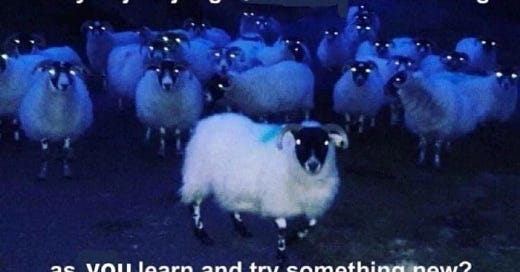This post is the 103rd edition of How To Do Things With Memes. I didn’t realize it when I crossed the threshold into 100, so the time for reflection and recapping is now.
I want to take this chance to express my gratitude to you: your attention means more than I can measure. It tells me I’m not alone in caring about these things, and that others share both my worries and my hopes. I’m thankful for you as a collaborator. For paid subscribers, I’ll go a bit more in detail, below the paywall, about future plans, my methodology, and what exactly you are supporting.
Following the lead of
at Creative R & D (who gave me the chance to write about satirical AI deepfakes on his newsletter a while back) I want to describe what my core ideas in this newsletter are.Memes are art
The experiences we have with internet culture are valuable. Memes are not just funny pictures or niche references. There is profound, meaningful aesthetic practice here, territory to explore. So I try to do is what a music writer or art critic does: I write reviews of memes, I tell their context and story. I take my own aesthetic experience and offer it as the petri dish on which I pipette the meme’s spores and let them bloom, so the microscope of analytic language may read their structure.
In another sense, I seek to be an art historian for memes. How might we periodize, classify, and understand memes? What broader patterns are detectable across groups of memes? In what ways does the development of technology and power express itself through memes?
Art, as a kind of evidence, testifies to past lives in a stranger and more intimate manner than other parts of the historical record. It opens into ambiguity and preserves the spirit of a moment, showing the way people understood or failed to understand one another.
Ways of communicating and doing art are also ways of structuring time, space, and audiences. I first became interested in memes because I loved poetry, and the rigid formal structures of some meme formats reminded me of older poetic forms. Poems rhyme in part so they are easier to memorize, sitcom episodes are half an hour long so they can fit a TV programming slot, albums tend to have a play time of around 45 minutes so they could fit on an LP. Form is a kind of compromise, to my eyes, between people and their historical situation. Art slots into our lives in the ways that technologies, markets, and social situations allow, and in so doing it solidifies these structures by giving voice to them. It reflects the currency of attention people were able to pay, and by its transaction allows them — and us, looking on from a distance — to appraise the substance of their varied experiences.
Poetry is often about pushing the bounds of what formal structures permit. It is about breaking the routine of language usage, making us read with fresh eyes the words and ideas that pass between us each day and consider the ways they shape our trajectories. A good poem makes you see your own mind and cultural life as a stranger would, and no longer take for granted what has been a given. Memes do the same thing, pushing the bounds of the post in strange directions.
Tech is a political question
Keep reading with a 7-day free trial
Subscribe to How To Do Things With Memes to keep reading this post and get 7 days of free access to the full post archives.




